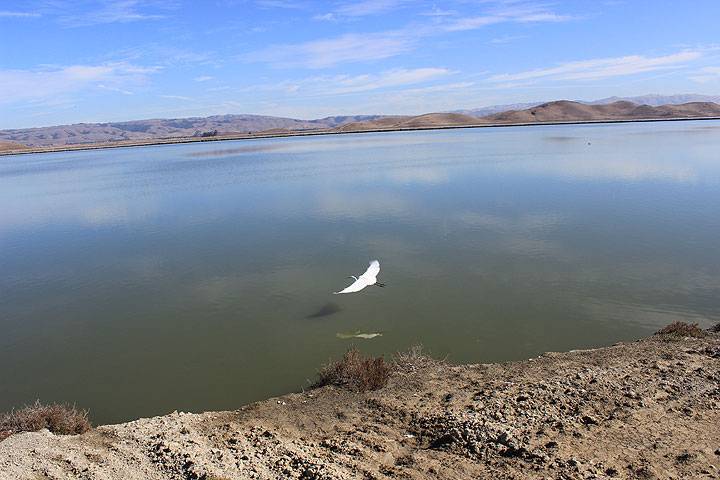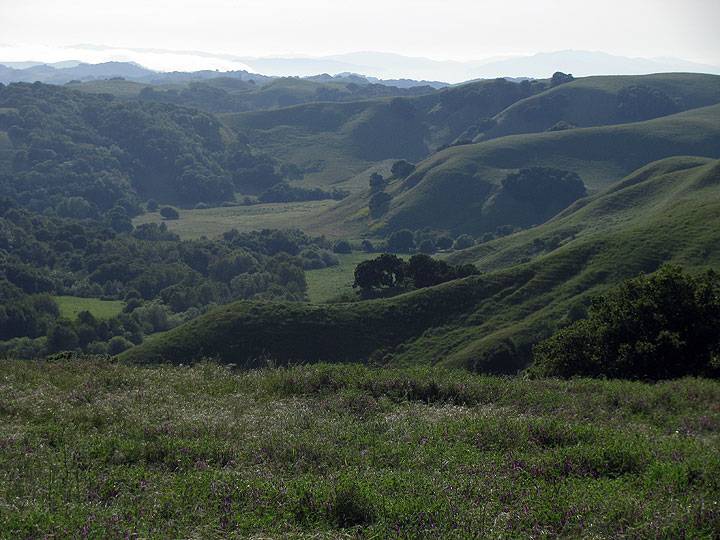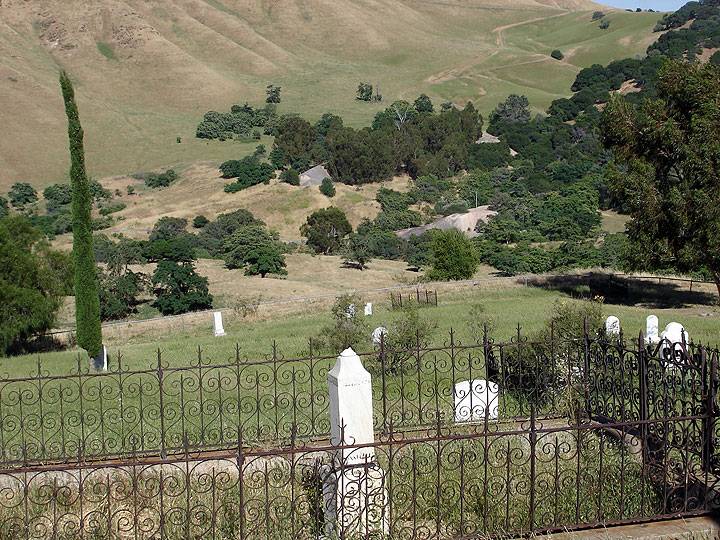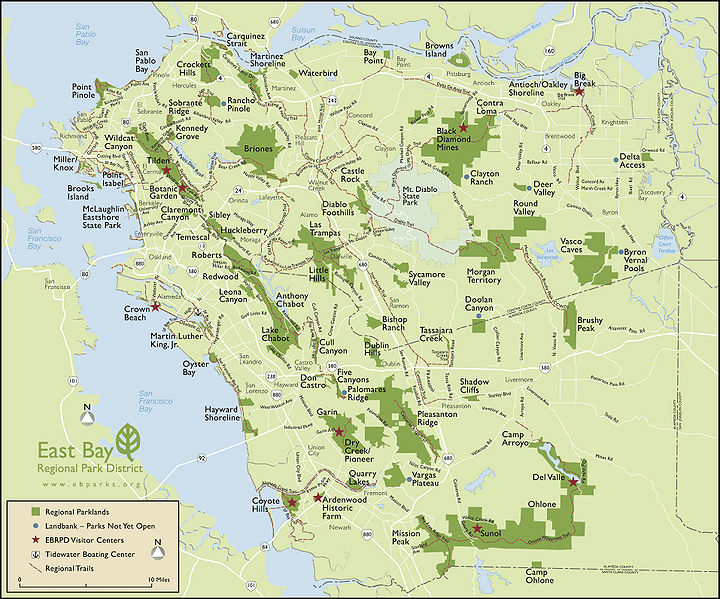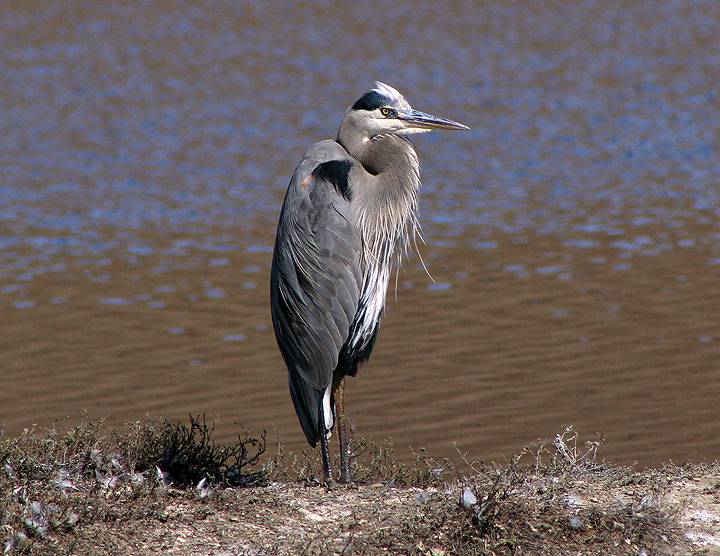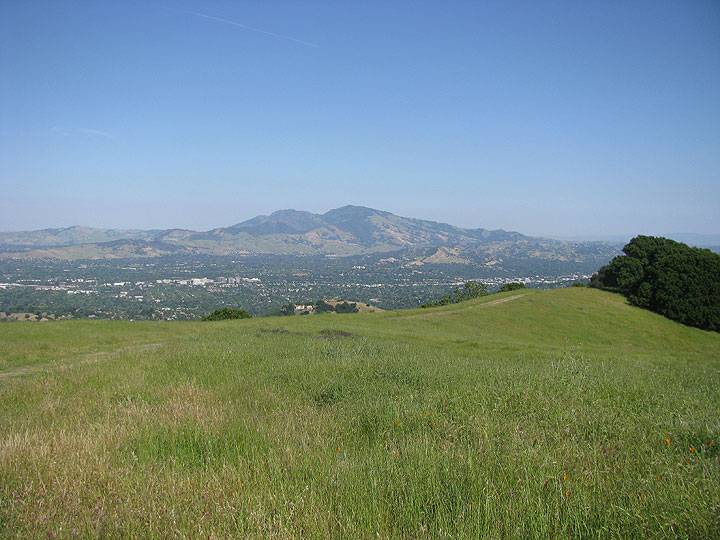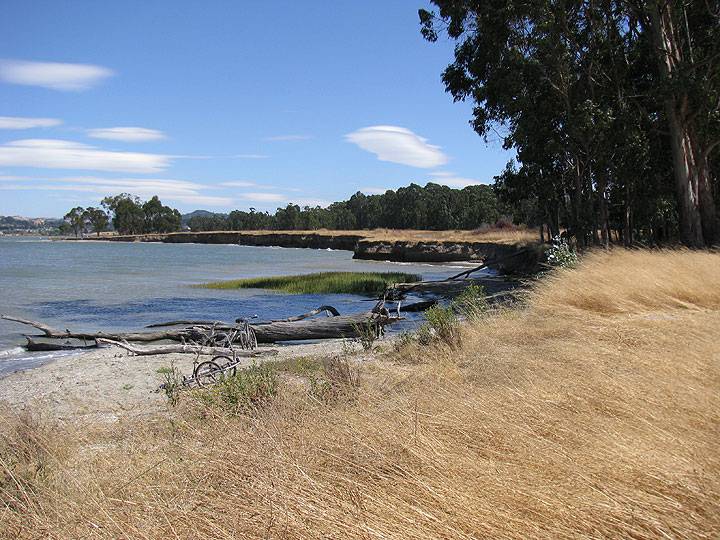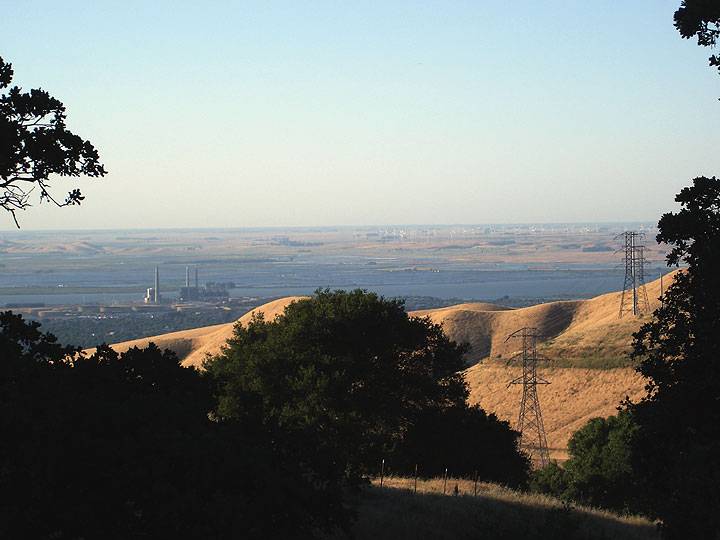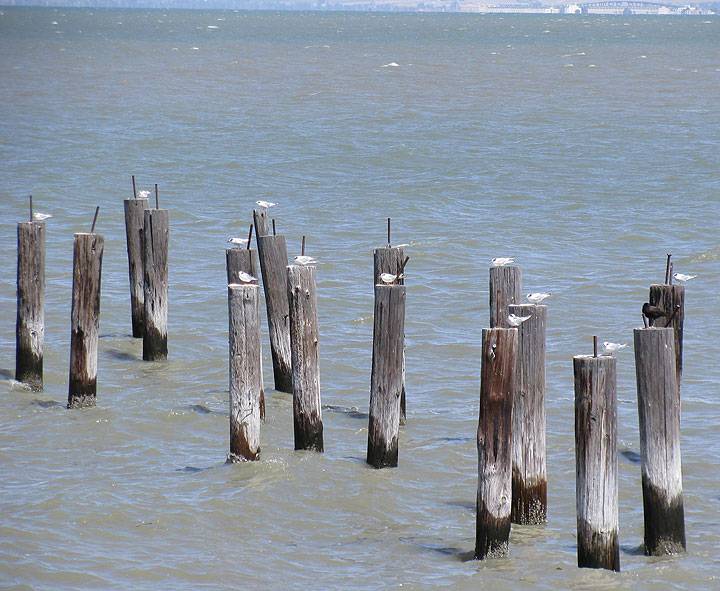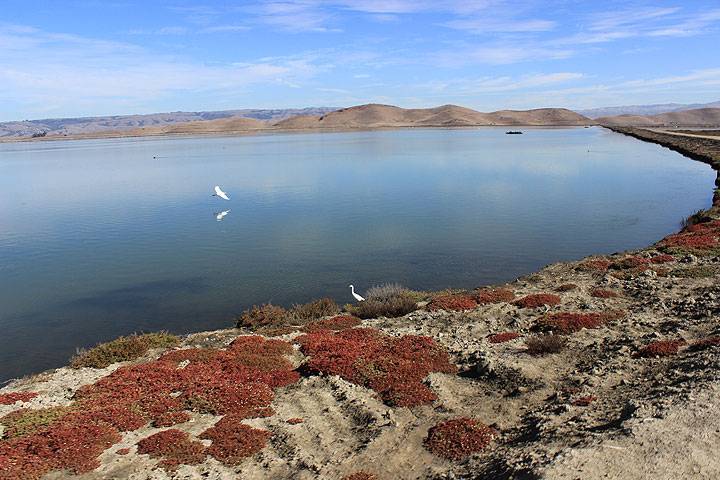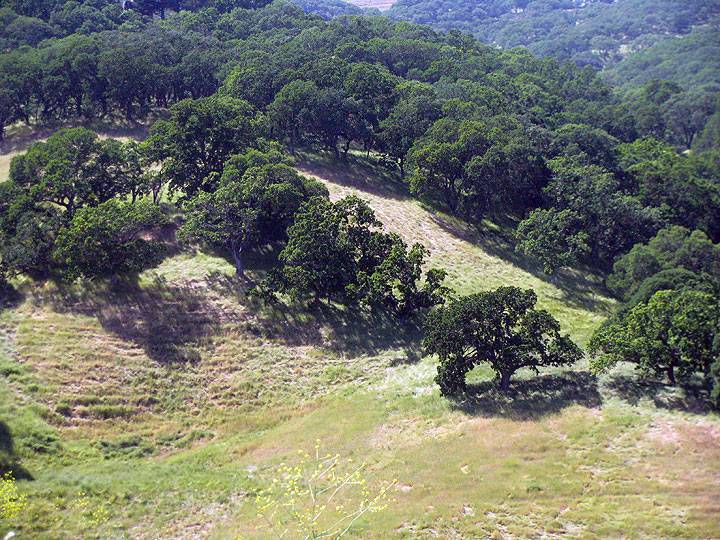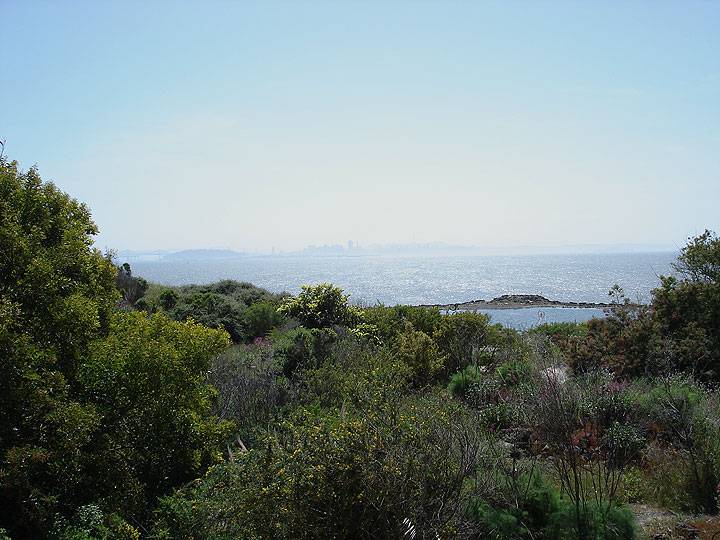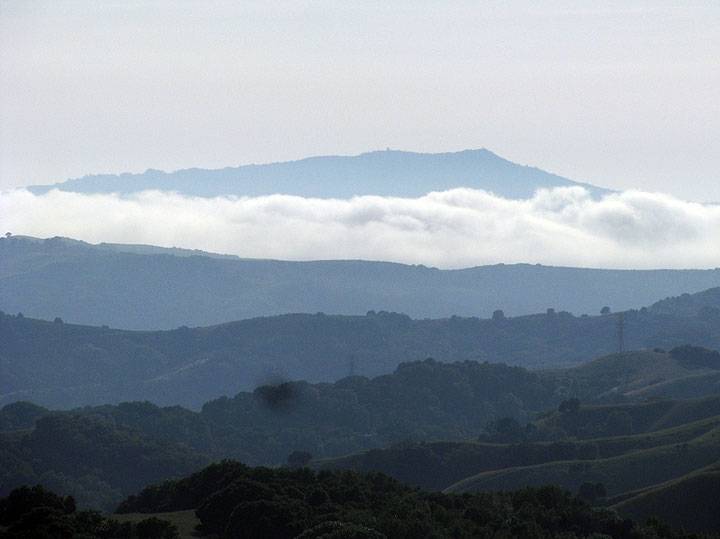East Bay Regional Parks at 75: The Lungs of the City
Historical Essay
by Richard Walker
Originally published in Bay Nature, October-December 2009.
Great white heron soaring over restored wetlands in Coyote Hills Regional Park, 2012.
Photo: Chris Carlsson
This year [2009] the East Bay Regional Park District (EBRPD), the nation’s largest local park district, is celebrating its 75th anniversary. Citizens of Alameda and Contra Costa counties can be justly proud of this extensive park system, covering 98,000 acres in 65 parks and preserves, and providing recreational facilities, open space, scenic views, and wildlife protection in the midst of millions of people. Regional parks stretch from San Francisco Bay to the Sacramento Delta and from the Carquinez Strait to Sunol. They extend along the spine of the Oakland-Berkeley Hills all the way to Union City and Pleasanton, hug the bayside from Fremont to Richmond, and grace the banks of the river from Martinez to Antioch.
The East Bay parks have served so many, so well, for so long that one might be inclined to become complacent, imagining that the future is secure. Nevertheless, the welfare of parks in California is by no means assured, as evidenced by the fate of the state parks, now threatened by closure due to budget cutting.
The question, then, is whether the East Bay Regional Park District can cope with the Four Horsemen of the Apocalypse bearing down on California: fiscal crisis, population growth, urban sprawl, and climate change. Keeping them at bay will entail sufficient funding to maintain and expand parklands; the capacity to serve a burgeoning and changing public, with many competing demands; an ability to wrestle with the exploding metropolis of the Bay Area; and a sufficient response to the ecological pressures wrought by a shifting climate.
View westward from ridgetop in Briones Regional Park.
Photo: Chris Carlsson
This 19th century cemetery is all that remains of several coal-mining towns that once dotted the north slopes of Mt. Diablo, in what is today Black Diamond Mines Regional Park.
Photo: Chris Carlsson
East Bay Regional Park District map.
courtesy East Bay Regional Parks
The Bucks Start Here
The financial base of the district is sound, thanks to the long-standing support of the citizenry. “Parks are a core value in the East Bay,” says Bob Doyle, assistant general manager for land acquisition. Voter approval of Measure WW in 2008 provided $500 million in capital bonds to fund land purchases, park upgrades, and trail extensions. A quarter of the money goes for grants to cities in the district for their own parks.
Last fall’s ballot measure passed by a whopping 72 percent of the bi-county electorate, despite the worst economic meltdown in three-quarters of a century. This is the same super-majority East Bay voters gave the measure that created the district in 1934 in the midst of the Great Depression. Neither victory was inevitable. After all, the cities of Oakland and Berkeley had failed in creating parks during the booming decades of the early 1900s.
Measure WW repeats the success of Measure AA, approved in 1988 for $250 million in bonded debt. The latter allowed for a huge increase in parklands—about 30,000 acres—in the last years of the 20th century. District managers nearly doubled their capital by the use of complementary funds from the state’s Bay Conservancy, grants from state park bonds, and development offsets.
And yet, despite its recent victory, the park district, like agencies across California, is facing budget cuts because the state is dipping into local revenues. A bigger problem may be the overall decline in property values, which determine the taxes the district receives. “That’s what funds all the parks,” says Doyle. “It’s fantastic that we have capital for acquisition and restoration, but we can’t open new parks without funding for operations.”
Nonetheless, the success of Measure WW proves that the park district still has a solid base of support, including environmentalists at the Sierra Club, local Audubon chapters, Save Mount Diablo, and more. Activists have worked closely with the EBRPD to safeguard open space, but also pushed it in new directions when necessary, such as the push for a bond measure in 1988, or the saving of Pleasanton Ridge, or the recent eminent domain acquisition of Breuner Marsh in Richmond.
Gray Heron at Coyote Hills Regional Park.
Photo: Chris Carlsson
Ridgetop meadow viewing eastward towards Mt. Diablo in Briones Regional Park.
Photo: Chris Carlsson
North shore of Pt. Pinole Regional Park.
Photo: Chris Carlsson
Parks For (and By) the People
The idea of public parks has evolved over time and the mandate of the regional park district has expanded along with it. Accessible outdoor recreation was the first order of business for the original parks in the Oakland-Berkeley Hills (Tilden, Sibley, Redwood) and recreation remains at the heart of the district’s mission. The East Bay parks include such notable swimming and fishing sites as Lake Anza, Del Valle, Crown Beach, Shadow Cliffs, and Quarry Lakes. The parks offer over 4,000 picnic tables and 200 campsites, and they include such attractions as the farm at Ardenwood, the steam train at Tilden, and the historic Black Diamond Mines.
The parks are meant to be used and they are, visited 14 million times every year by people from all over the Bay Area. Not surprisingly, those who use the parks are far more likely to support park financing than those who do not—80 percent versus 52 percent. Changing demographics are not undermining support for open space: District polling shows that African-Americans and Asian-Americans voted in higher percentages for Measure WW than Euro-Americans, and Latinos only slightly less.
Accessibility is a keyword. The district’s stated goal is to have a park or trailhead within 10 to 15 minutes’ drive of every household in the East Bay. A Parks Express program offers low-cost charter buses and vans to groups serving children, low-income areas, and people with disabilities. The district also has one of the most extensive trail systems in the country, over 1,150 miles in all.
The district’s mission has changed along with its geography. From an original conception of a chain of woodsy hilltop retreats for the urban masses, the district shifted gears in the 1960s under General Manager William Penn Mott, Jr. to embrace wide-open grassland parks (Briones, Wildcat Canyon, Garin) and bayside parks (Alameda Beach, Coyote Hills, Point Pinole). And it was Mott who first emphasized the district’s interpretive programs, now staffed by the nation’s largest regional park naturalist staff.
In the 1970s, more emphasis was put on staying ahead of urban sprawl. Under Richard Trudeau, the district took a great leap east toward Mount Diablo (Black Diamond, Morgan Territory, Diablo Foothills) and the Delta (Brown’s Island, Big Break) and expanded dramatically to the south in the Tri-Valley area (Tassajara Ridge, Bishop Ranch, Del Valle) and the Diablo Range (Sunol, Mission Peak, Ohlone).
Today, district managers keep pushing eastward, where new urban growth is greatest. Creating parks in places like Concord Naval Weapons Station and Deer Valley on the eastern slope of Mount Diablo will be essential to serve future generations. At the same time, a critical target is the inner East Bay from Richmond to Hayward, where the city is the densest and the people have the least resources. Here the parks must juggle an array of competing demands, from recreation to habitat protection. This is also where sea-level rise due to climate change threatens parks and millions of dollars worth of wetlands restoration.
Balancing all these variables is no mean trick. “It’s a Rubik’s cube for the staff,” acknowledges one manager. An acute case is the new Eastshore State Park, managed by the district for the state. On this bare sliver of 80 abused acres between the Bay and I-80, a multiple-use park is gradually taking shape with biking trails, ballparks, boat launches, and restored coastal vegetation. Those competing demands, however, have helped the district step up to the plate on critical fronts. It is not just far-sighted managers who have brought the park system to its present state, but activists who refused to give up on their vision—people like Bob Walker and Mary Bowerman fighting for Mount Diablo or Jean Siri and Norman LaForce along the East Bay shore.
Black Diamond Mine Regional Park, view northerly towards Antioch and the delta wind farms.
Photo: Chris Carlsson
View of San Francisco bay from hilltop in Tilden Regional Park.
Photo: Chris Carlsson
Shorebirds roosting on old Powder Works docks off Pt. Pinole Regional Park.
Photo: Chris Carlsson
Regional Powerhouse
For decades, the East Bay has faced pressures from suburban expansion. The I-680 corridor is now the central spine of the region and east Contra Costa County is no longer predominately rural. Thanks to the financial bubble, growth got out of control over the last decade, with sprawl quickly consuming farmland.
In this urbanized environment, parks and open space have become a means of delimiting and directing urban development. As General Manager Pat O’Brien observes, “Without our parks, the East Bay would look very different.” He should know: The park district is now the largest single landowner in the East Bay and a formidable force in the halls of local governments overseeing land use decisions.
The district’s full-time planning unit not only looks ahead to future parkland but looks over the shoulders of city officials. This sometimes requires dramatic action, as when it used eminent domain to seize Breuner Marsh in Richmond from a developer who planned to build nearby.
When it comes to land conservation and development in the East Bay, the park district is the most important player in the game: The district has the weight to keep open space protection on the table every time.
But with power comes the impossible task of keeping many contending interests happy. Mountain bikers, frustrated that more trails aren’t open to them, mounted some of the most visible opposition to last year’s park bond. Other activists want the district to do more to limit cattle grazing and recreational use in sensitive areas, which can lead to habitat degradation for rare species.
Coyote Hills Regional Park.
Photo: Chris Carlsson
Briones Regional Park.
Photo: Chris Carlsson
McLaughlin Eastshore Regional Park, view of San Francisco from the Albany Bulb.
Photo: Chris Carlsson
The Web of Land
What stands out on a map of open space in the greater East Bay is that the whole is greater than the sum of the parts. The park district is only one actor among many in an immense web of parks, watersheds, and other protected areas. But it is at the center of the web and pivotal in regional land management.
Regional thinking about land conservation began with the 1933 Olmsted-Hall report that served as blueprint for the district. It foresaw today’s chain of parks and trails that run along the East Bay Hills, down creek beds, and along the shorelines.
Over the last generation, conservation biology has brought a sea change to open space management, with its emphasis on protecting whole ecosystems. Out of this came the idea of open space for nature’s sake, including migration corridors, urban creeks, and restored marshes. “We’re looking not for a map dotted with preserves, but a map with a network or web of open space,” says Save Mount Diablo’s Seth Adams. “We in the Bay Area are at the forefront of that idea.”
With good reason. The East Bay, particularly Mount Diablo, is one of four biodiversity “hotspots” in California, itself the most diverse region in the continental United States. “There are many ‘last great places’ left, right here in the East Bay,” remarks Adams, putting a new spin on the words of David Brower.
The park district pays close attention to habitat stewardship. Staff biologists oversee grazing practices by ranchers who lease grazing rights, and carry out studies of wildlife feeding, breeding, and recovery. As a result of such conservation practices, organisms such as native grasses, red-legged frogs, and falcons have rebounded in protected areas.
But climate change makes everything more complicated. Wildlife in the interior will face hotter summers, longer droughts, and more wildfires. Shoreline areas will see marshes and trails threatened by rising sea levels. “All those things are going to be a huge challenge,” says Doyle. “It’s not going to stop the public from enjoying their parks, but we’re an agency that places a high priority on native species, so it’s a big concern for us.”
Westerly view from ridgetop in Briones Regional Park, showing layers of hills before fog pours into SF Bay, with Mt. Tamalpais in Marin looming above the fog.
Photo: Chris Carlsson
Future People for Open Space
People, too, benefit from open space that gives them more breathing room. New parks at the eastern edges of the metropolis will prove ever more vital as the city expands and generations to come seek solace in nature nearer their doorsteps. With global warming, we should revive the dictum of Frederick Law Olmsted, father of American parks, that parks are “the lungs of the city.”
Education to ensure that people understand the benefits of open space is another essential function of the East Bay parks. Working with schools is a big part of that, with students taking field trips to the parks and park rangers going into classrooms. “We aren’t just teaching about butterfly biology and who eats what snake,” says longtime chief naturalist Ron Russo, now retired. “The naturalist staff and student aides also serve as a front door, introducing people to what the regional parks are all about.”
Central to that role are the nine visitors’ centers spread across the system, from Tilden to Coyote Hills. Another is in the works at Big Break near Antioch, as is a “visitor center on wheels” complete with traveling aquarium. Every year, more than 400,000 people visit the district’s nature centers or take part in naturalist-led programs.
Facing threats both fiscal and physical from the state budget crisis, urban growth, and climate change, the East Bay Regional Park District will not be entirely spared by California’s Four Horsemen. Nevertheless, the agency is in remarkably good shape and aging gracefully. All signs points to it staying healthy for generations to come, because district leaders, park lovers, and the people of the East Bay are alert to the dangers—and the opportunities—ahead.
Richard A. Walker recently retired from being a professor of geography at the University of California at Berkeley and is the author, most recently, of The Country in the City: The Greening of the San Francisco Bay Area.

